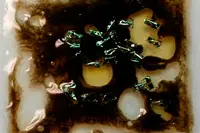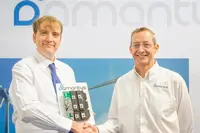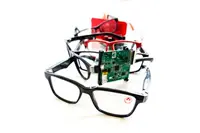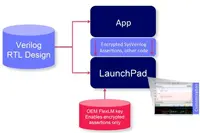Electronics News
Archive : 22 May 2015 год
 Demand for semiconductors through European distributors grew strongly in the first quarter of 2015, continuing the positive trend shown in the last half of 2014, according to DMASS – the Distributors' and Manufacturers' Association of Semiconductor Specialists. Sales of semiconductors through distribution channels in Q1 grew by 13.3% year on year to €1.82billion, the highest recorded quarterly sales since the introduction of the Euro in 2002, said DMASS.
Demand for semiconductors through European distributors grew strongly in the first quarter of 2015, continuing the positive trend shown in the last half of 2014, according to DMASS – the Distributors' and Manufacturers' Association of Semiconductor Specialists. Sales of semiconductors through distribution channels in Q1 grew by 13.3% year on year to €1.82billion, the highest recorded quarterly sales since the introduction of the Euro in 2002, said DMASS.
While currency effects have had an impact, DMASS chairman Georg Steinberger said: "Even neglecting exchange rate effects, the distribution market enjoyed stable sales growth. The downside is a wave of price increases from overseas suppliers to compensate exchange rate effects."
DMASS says around half of the growth can be attributed to exchange rate issues, with most European customers billed in US dollars,
While sales in the UK grew by 16.3% to €158million, sales in Germany (5.8%) and Italy (8.4%) were less than average.
Steinberger added: "Sales in Germany, Italy and a few smaller markets have been more Euro focused, with the effect that their single digit growth rates are more in line with a realistic market growth."
Sales of analogue products grew to €537m, MOS Micro contributed €371m and power product revenues were €175m.
Author
Graham Pitcher
Source: www.newelectronics.co.uk
 University of Illinois researchers have developed heat-triggered self-destructing electronic devices, a step toward reducing electronic waste and boosting sustainability in device manufacturing.
University of Illinois researchers have developed heat-triggered self-destructing electronic devices, a step toward reducing electronic waste and boosting sustainability in device manufacturing.
The researchers, led by aerospace engineering professor Scott White, published their work in the journal Advanced Materials.
"We have demonstrated electronics that are there when you need them and gone when you don't need them anymore," Prof White said. "This is a way of creating sustainability in the materials that are used in modern-day electronics. This was our first attempt to use an environmental stimulus to trigger destruction."
Prof White's group teamed up with John Rogers, a materials science and engineering specialist at Illinois. Rogers' group has pioneered transient devices that dissolve in water, with applications for biomedical implants.
Describing the goal of the research, Prof White said: "If you can't keep using something, whether it's obsolete or just doesn't work anymore, we'd like to be able to bring it back to the building blocks of the material so you can recycle them when you're done, or if you can't recycle it, have it dissolve away and not sit around in landfills."
The heat-triggered devices use magnesium circuits printed on thin, flexible materials. The researchers trap microscopic droplets of a weak acid in wax and coat the devices with the wax. When the devices are heated, the wax melts, releasing the acid which dissolves the device completely.
The team also developed a radio-controlled trigger that could activate self-destruction remotely on demand. To trigger the reaction, an RF receiver and an inductive heating coil were embedded in the device. The user can send a signal to cause the coil to heat up, which melts the wax and dissolves the device.
The researchers can control how fast the device degrades by tuning the thickness of the wax, the concentration of the acid and the temperature. They can design a device to self-destruct as quickly as 20s after heat is applied.
The devices also can be designed to degrade in steps by encasing different parts in waxes with different melting temperatures. This gives more precise control over which parts of a device are operative, creating possibilities for sophisticated devices that can sense something in the environment and respond to it.
Watch the video showing the researchers describing self-destructing electronics.
Author
Tom Austin-Morgan
Source: www.newelectronics.co.uk
 Regensburg based Maschinenfabrik Reinhausen (MR) has acquired all of Amantys' industrial property rights, including patents and brands, as well as most of its technical facilities and equipment.
Regensburg based Maschinenfabrik Reinhausen (MR) has acquired all of Amantys' industrial property rights, including patents and brands, as well as most of its technical facilities and equipment.
MR is a leading developer of power transformers, employs about 3000 people and has revenues of €650million. It says the deal represents another important stage in the implementation of its long term technology strategy and opens up a variety of technological possibilities for expansion and optimization of the future product and application portfolio.
As part of the deal, MR has established a wholly owned subsidiary in Cambridge with Amantys Power Electronics. Activity will include R&D, as well as the manufacture, marketing and sales of products and services for power electronics and the regulation and control of electrical networks.
The team will include a number of ex Amantys employees and MR is looking to 'reactivate and optimise' the existing product portfolio. At the same time, Amantys' technology will be further developed.
Amantys was established in 2010, with backing from ARM, with the intention of revolutionising the medium and high voltage power electronics sector. However, it failed to gather momentum and was shut in May 2015.
Pic: Dr Uwe Kaltenborn, left, head of corporate technology for the Reinhausen Group, with Dr Mark Snook, Amantys Power Electronics’ head of technology
Author
Graham Pitcher
Source: www.newelectronics.co.uk
 Ophthalmic technology group and eye care retailer VSP Global has announced the development of 'Project Genesis', a wearable prototype pair of optical frames that integrates health-tracking technology.
Ophthalmic technology group and eye care retailer VSP Global has announced the development of 'Project Genesis', a wearable prototype pair of optical frames that integrates health-tracking technology.
Sensors, including an accelerometer and gyros, integrated into the temples of the glasses track health metrics such as steps, calories burned, heart rate, posture, gait, activity time and distance travelled. That information is passed, via Bluetooth, to a custom application that allows the wearer to monitor their activity in real time and which, according to VSP, has the potential to start identifying trends and behaviours that can create a more proactive healthcare model.
Rob Lynch, ceo of VSP Global said: "With an understanding of a rapidly changing marketplace and increased expectations from our clients and members, The SHOP's purpose is to drive technological advancements that are helping to shape tomorrow's optical industry."
The SHOP is VSP's innovation lab, the focus of which is designing the products and integrating the health tracking devices into the frames. It is currently beta testing the first version of the prototype with 26 VSP employees at the company's headquarters. Participants have been providing real-time feedback to SHOP engineers and designers, allowing for development of the prototype's hardware and software.
Additional testing and development is underway, with newer versions of the prototype expected to include more frame designs and additional sensors to provide more meaningful health data.
Jeremy Chadwick, managing director for VSP Vision Care EMEA, said: "Project Genesis proves to the market how seriously we believe in innovation in the area of eye health and vision care to create the next wave of optical technology that will improve both lifestyle and wellbeing for our members."
Author
Tom Austin-Morgan
Source: www.newelectronics.co.uk
 Looking to create a market in formal verification apps, OneSpin Solutions has launched a software platform that allows third party companies with limited knowledge of formal technology to develop and deliver domain specific formal based apps.
Looking to create a market in formal verification apps, OneSpin Solutions has launched a software platform that allows third party companies with limited knowledge of formal technology to develop and deliver domain specific formal based apps.
Called 360 LaunchPad, the software can be delivered as part of the app by the developer or the app can be included in the OneSpin App Library, working with its formal products.
"We're taking our assertion based engine and packaging it so other companies can use it inside their products," said Dave Kelf, vp of marketing.
To date, Agnisys and Tortuga Logic have integrated LaunchPad into their products. Tortuga has used it as part of its Prospect hardware security product line, while Agnisys' ARV-Formal combines LaunchPad with its Automatic Register Verification app to ensure register operations in an RTL design are formally proven to match a specification.
Kelf said he expected this approach to enable more tools to be created. "We think there could be a couple of hundred customers in the IP sector," he continued.
According to OneSpin, apps could be an effective way to target formal based technology at certain verification problems. Until now, these apps have been built into formal verification tools and developed and delivered by the formal verification tool vendor.
LaunchPad encapsulates a complete formal platform in such a way that its can be integrated into specialised systems by engineers without a formal technology background.
Author
Graham Pitcher
Source: www.newelectronics.co.uk

